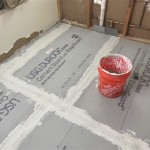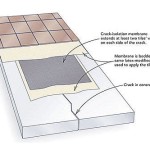Can I Put Tile Over a Concrete Patio?
A concrete patio provides a durable and versatile outdoor surface. However, plain concrete can lack aesthetic appeal. Tiling offers a way to enhance the look and feel of a patio while maintaining a robust foundation. This article explores the feasibility and considerations of installing tile over an existing concrete patio.
Assessing the Concrete Patio's Suitability
Before embarking on a tiling project, careful assessment of the existing concrete is crucial. Several factors determine whether the concrete is suitable for tiling:
- Stability: The concrete must be stable and free from significant cracks or movement. Shifting or unstable concrete will cause the tile installation to fail.
- Drainage: Proper drainage is essential to prevent water accumulation under the tiles, which can lead to damage. The patio should have a slight slope to facilitate water runoff.
- Cleanliness: The concrete surface must be clean and free from any debris, oil, or sealant that could interfere with the adhesion of the thin-set mortar.
- Curing: Newly poured concrete requires adequate curing time, typically 28 days, before tiling can commence. This allows the concrete to reach its full strength and minimize shrinkage cracks.
Choosing the Right Tile
Selecting appropriate tiles for outdoor use is paramount. The tiles must withstand the elements and the demands of pedestrian traffic. Consider the following factors when choosing tiles:
- Durability: Opt for porcelain or ceramic tiles rated for outdoor use. These tiles are denser and less porous than indoor tiles, making them more resistant to moisture, freeze-thaw cycles, and impact.
- Slip Resistance: Safety is a primary concern. Choose tiles with a textured surface or a high coefficient of friction to minimize the risk of slips and falls, especially when the surface is wet.
- Aesthetics: Consider the overall design and style of the outdoor space. Select tiles that complement the existing landscaping and architecture.
- Thickness: Thicker tiles are generally more durable and better suited for high-traffic areas.
Preparing the Concrete Surface
Proper surface preparation is critical for successful tile adhesion. The following steps outline the necessary preparations:
- Cleaning: Thoroughly clean the concrete surface using a pressure washer or a stiff-bristled brush and a suitable cleaning solution. Remove any dirt, grease, or loose debris.
- Repairing Cracks: Fill any cracks or imperfections in the concrete using a concrete patching compound. Allow the patch to dry and cure completely before proceeding.
- Applying Primer: A concrete primer enhances the bonding between the thin-set mortar and the concrete surface. Apply a suitable primer according to the manufacturer's instructions.
Installing the Tile
The tile installation process requires precision and attention to detail. The following steps provide a general overview:
- Layout Planning: Plan the tile layout to minimize cuts and ensure a balanced appearance. Begin laying tiles from the center of the patio and work outwards.
- Applying Thin-Set Mortar: Spread a layer of thin-set mortar onto the concrete surface using a notched trowel. The size of the notches will depend on the size and type of tile being used.
- Setting the Tile: Firmly press each tile into the mortar bed, ensuring full contact. Use spacers to maintain consistent grout lines.
- Cutting Tiles: Use a tile cutter or wet saw to cut tiles to fit around edges and obstacles.
Grouting and Sealing
Once the tile adhesive has cured, grouting and sealing complete the installation process.
- Applying Grout: Apply grout to the joints between the tiles using a grout float. Remove excess grout with a damp sponge.
- Sealing the Grout: After the grout has dried, apply a grout sealer to protect it from staining and moisture penetration.
Maintenance and Longevity
Regular maintenance will prolong the life and beauty of the tiled patio.
- Cleaning: Sweep or hose down the patio regularly to remove dirt and debris.
- Sealing (Optional): Periodically sealing the tiles can enhance their resistance to staining and fading.
- Inspections: Regularly inspect the tiled surface for any signs of damage, such as cracked tiles or loose grout. Address any issues promptly to prevent further deterioration.
Tiling over a concrete patio can dramatically enhance its aesthetic appeal and create a functional and inviting outdoor space. By carefully assessing the concrete's suitability, choosing appropriate materials, and following proper installation techniques, a durable and beautiful tiled patio can be achieved.

How To Install Tile Over An Existing Concrete Patio The Rta

How To Install Tile Over Concrete Greenbuildingadvisor
:max_bytes(150000):strip_icc()/can-you-install-tile-directly-on-concrete-1822600-04-458f7bb6c78348c1835cf8054ef36553.jpg?strip=all)
How To Install Tile Over Concrete

Leveling And Dry Fitting Tile In An Outdoor Area Patio Tiles Exterior Over Concrete

Concrete Patio Transformation 7 Steps To Diy A New Outdoor Oasis

Outdoor Tile Over Concrete Unique

Tiling A Concrete Patio Lifestyleqld

Home Depot Outdoor Patio Tile Tiles Over Darbylanefurniture Com Decor Pavers Design Concrete

Stone Over Concrete Porch Welcome Home Quinju Com

Tiling The Complete Guide To Choosing Best Outdoor Tile
Related Posts








